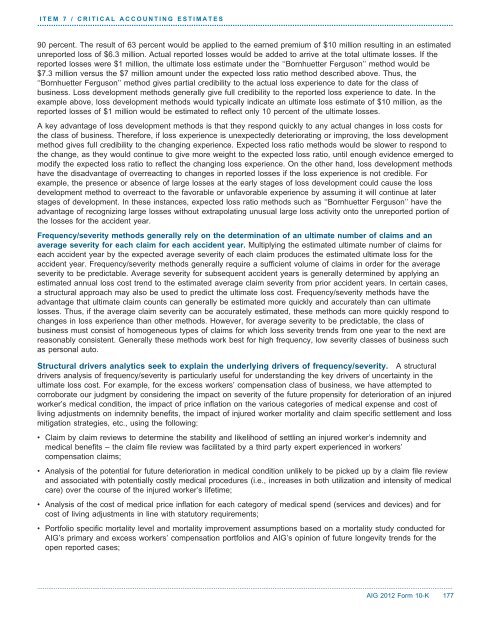Bring on tomorrow - AIG.com
Bring on tomorrow - AIG.com
Bring on tomorrow - AIG.com
You also want an ePaper? Increase the reach of your titles
YUMPU automatically turns print PDFs into web optimized ePapers that Google loves.
ITEM 7 / CRITICAL ACCOUNTING ESTIMATES.....................................................................................................................................................................................90 percent. The result of 63 percent would be applied to the earned premium of $10 milli<strong>on</strong> resulting in an estimatedunreported loss of $6.3 milli<strong>on</strong>. Actual reported losses would be added to arrive at the total ultimate losses. If thereported losses were $1 milli<strong>on</strong>, the ultimate loss estimate under the ‘‘Bornhuetter Fergus<strong>on</strong>’’ method would be$7.3 milli<strong>on</strong> versus the $7 milli<strong>on</strong> amount under the expected loss ratio method described above. Thus, the‘‘Bornhuetter Fergus<strong>on</strong>’’ method gives partial credibility to the actual loss experience to date for the class ofbusiness. Loss development methods generally give full credibility to the reported loss experience to date. In theexample above, loss development methods would typically indicate an ultimate loss estimate of $10 milli<strong>on</strong>, as thereported losses of $1 milli<strong>on</strong> would be estimated to reflect <strong>on</strong>ly 10 percent of the ultimate losses.A key advantage of loss development methods is that they resp<strong>on</strong>d quickly to any actual changes in loss costs forthe class of business. Therefore, if loss experience is unexpectedly deteriorating or improving, the loss developmentmethod gives full credibility to the changing experience. Expected loss ratio methods would be slower to resp<strong>on</strong>d tothe change, as they would c<strong>on</strong>tinue to give more weight to the expected loss ratio, until enough evidence emerged tomodify the expected loss ratio to reflect the changing loss experience. On the other hand, loss development methodshave the disadvantage of overreacting to changes in reported losses if the loss experience is not credible. Forexample, the presence or absence of large losses at the early stages of loss development could cause the lossdevelopment method to overreact to the favorable or unfavorable experience by assuming it will c<strong>on</strong>tinue at laterstages of development. In these instances, expected loss ratio methods such as ‘‘Bornhuetter Fergus<strong>on</strong>’’ have theadvantage of recognizing large losses without extrapolating unusual large loss activity <strong>on</strong>to the unreported porti<strong>on</strong> ofthe losses for the accident year.Frequency/severity methods generally rely <strong>on</strong> the determinati<strong>on</strong> of an ultimate number of claims and anaverage severity for each claim for each accident year. Multiplying the estimated ultimate number of claims foreach accident year by the expected average severity of each claim produces the estimated ultimate loss for theaccident year. Frequency/severity methods generally require a sufficient volume of claims in order for the averageseverity to be predictable. Average severity for subsequent accident years is generally determined by applying anestimated annual loss cost trend to the estimated average claim severity from prior accident years. In certain cases,a structural approach may also be used to predict the ultimate loss cost. Frequency/severity methods have theadvantage that ultimate claim counts can generally be estimated more quickly and accurately than can ultimatelosses. Thus, if the average claim severity can be accurately estimated, these methods can more quickly resp<strong>on</strong>d tochanges in loss experience than other methods. However, for average severity to be predictable, the class ofbusiness must c<strong>on</strong>sist of homogeneous types of claims for which loss severity trends from <strong>on</strong>e year to the next arereas<strong>on</strong>ably c<strong>on</strong>sistent. Generally these methods work best for high frequency, low severity classes of business suchas pers<strong>on</strong>al auto.Structural drivers analytics seek to explain the underlying drivers of frequency/severity. A structuraldrivers analysis of frequency/severity is particularly useful for understanding the key drivers of uncertainty in theultimate loss cost. For example, for the excess workers’ <strong>com</strong>pensati<strong>on</strong> class of business, we have attempted tocorroborate our judgment by c<strong>on</strong>sidering the impact <strong>on</strong> severity of the future propensity for deteriorati<strong>on</strong> of an injuredworker’s medical c<strong>on</strong>diti<strong>on</strong>, the impact of price inflati<strong>on</strong> <strong>on</strong> the various categories of medical expense and cost ofliving adjustments <strong>on</strong> indemnity benefits, the impact of injured worker mortality and claim specific settlement and lossmitigati<strong>on</strong> strategies, etc., using the following:• Claim by claim reviews to determine the stability and likelihood of settling an injured worker’s indemnity andmedical benefits – the claim file review was facilitated by a third party expert experienced in workers’<strong>com</strong>pensati<strong>on</strong> claims;• Analysis of the potential for future deteriorati<strong>on</strong> in medical c<strong>on</strong>diti<strong>on</strong> unlikely to be picked up by a claim file reviewand associated with potentially costly medical procedures (i.e., increases in both utilizati<strong>on</strong> and intensity of medicalcare) over the course of the injured worker’s lifetime;• Analysis of the cost of medical price inflati<strong>on</strong> for each category of medical spend (services and devices) and forcost of living adjustments in line with statutory requirements;• Portfolio specific mortality level and mortality improvement assumpti<strong>on</strong>s based <strong>on</strong> a mortality study c<strong>on</strong>ducted for<strong>AIG</strong>’s primary and excess workers’ <strong>com</strong>pensati<strong>on</strong> portfolios and <strong>AIG</strong>’s opini<strong>on</strong> of future l<strong>on</strong>gevity trends for theopen reported cases;..................................................................................................................................................................................................................................<strong>AIG</strong> 2012 Form 10-K 177
















